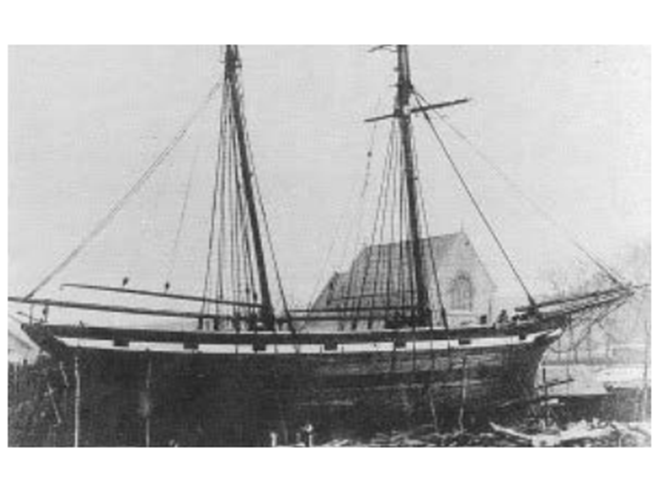


The schooner, “Heroine”, was owned and commanded by Captain Martin McKenzie. In the 1840s, it was employed trading between south-east Asia, Port Essington and Sydney, being one of the earliest vessels to pass through Torres Strait from west to east, then beating her way south outside the Great Barrier Reef.
“Heroine” was involved in two mishaps – the first one on August 5, 1845 while travelling west through Endeavour Strait. She struck an uncharted rock and, though damaged, was able to proceed. McKenzie reported this to Lieutenant Yule, RN in HMS “Bramble” who was in the area conducting surveys but Yule found this hard to believe having carried out a detailed survey of the Strait in 1844. However, in June 1846, Yule investigated the report and found an isolated rock in the position reported by McKenzie.
Yule's report was published in the “Sydney Morning Herald” October 14, 1846. By coincidence, the second mishap – this time resulting in the sinking of the schooner – and which occurred on April 24, 1846, was reported on the same page as Lt Yule’s report. Consequently, the two incidents were confused as one and the same and so arose the mistaken belief that the wreck of the “Heroine” was in Endeavour Strait.
But the wreck actually occurred near the Cumberland Islands. At 1 am on April 24, the schooner was near the Cumberland Islands/Gloucester Island when it struck a reef with such force that she began to sink immediately, disappearing within ten minutes and allowing no time for boats to be lowered.
It was fortunate that “Heroine” had been towing a boat for delivery to Post Essington and twenty-six of her complement had taken refuge in it. Nevertheless, nine people died, two of them the young daughters of McKenzie. He had been forced to take to the water with his younger daughter, an infant and spent five hours swimming before being rescued. Sadly, his daughter died and he had discarded her body.
Some of the crew swam to a small sand-bank from which they were picked up next morning but one of the remarkable features of the story is that four people, a priest, McKenzie's Timorese wife and two Malay women who had been clinging to the topmast of “Heroine” were rescued by a Newfoundland dog, Nelson, which had taken them individually to the sand-bank. Sadly, Nelson was later to be taken by a crocodile at Port Essington.
As to the precise location of the wreck of “Heroine”, the following clues give some indication.
While abreast of the Cumberland Islands, McKenzie calculated they were about five miles off, it being apparent they had chosen to pass to the east of the group. However, according to Rae, chief mate, they were in fact twenty /twenty-five miles off and this makes it likely, indeed inevitable, that the reef “Heroine” struck was in the area of today's Hook/Hardy/Bait Reefs. Weight is added to this theory by the fact some of the crew swam to a small sand-bank before being rescued. This perhaps was the small cay on today's Triangle Reef. It is not improbable the cay could have existed in 1846 because some further south, reported by Matthew Flinders in 1802, still exist today.
Further, the “Sydney Morning Herald” October 14, 1846, reported the sinking as being on “The Cumberland Reefs, the island bearing south by west.” Another mentions it was “off the Cumberland Islands in latitude 20S.” Hook Reef's southern edge actually lies on 19.50S.
To add a little spice to the story, Rae reported that as “Heroine” was sinking, McKenzie rushed to his cabin to retrieve 300 gold sovereigns but found the cabin half full of water and the coins remained where they were.
Obviously, treasure lies out there somewhere. The real surprise is that no efforts have been made to recover the schooner’s valuable cargo from its watery grave near the western end on Hook Reef. Now where did I leave my snorkel?
Story and photo courtesy of Proserpine Historical Museum and “The Whitsunday Islands - An Historical Dictionary” by the late Ray Blackwood.